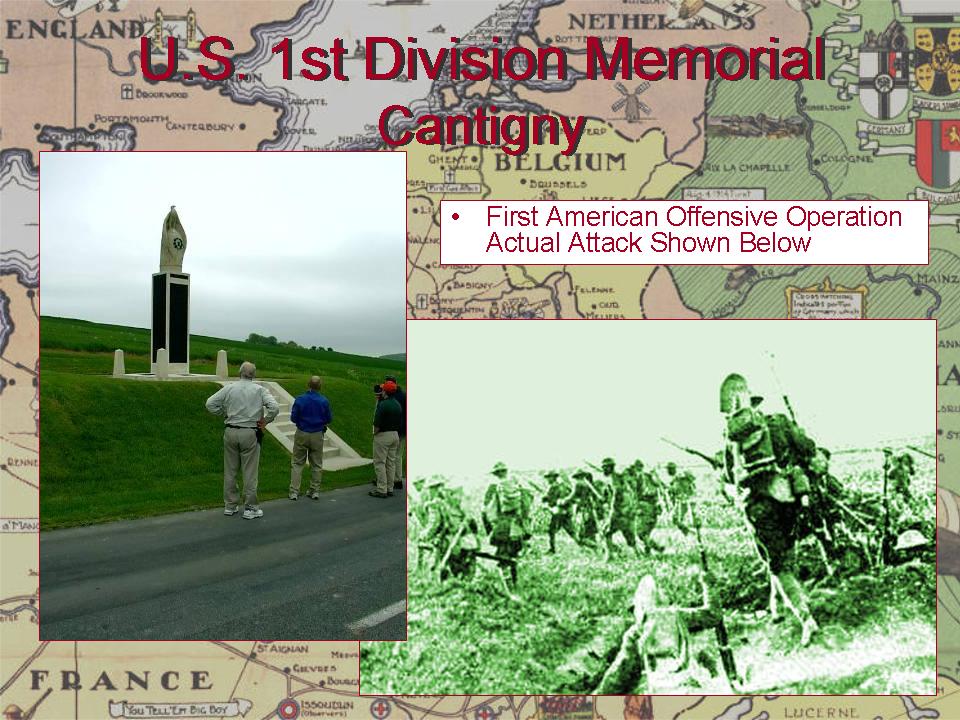
I want to thank our regular readers for the suggestions we have received on our Virtual Tour. In the future we will be having fewer slides, but with more information on the featured site. Today we are moving into the Somme sector, where we will be stopping at various sites from both 1916 and 1918.
Click on Image to Expand

Quick Facts
Where: The Somme Sector, North of Paris
When: May 28 - 30, 1918
AEF Units Participating: 1st Division
US Commander: Major General Robert L. Bullard
Opposing Forces: German 82nd Reserve Division
Memorable For: First US Offensive and Victory.
How It Looked To A Doughboy
Into the village of Cantigny we go. There remained nothing but ruins. We passed on through to the other side of the village. Here we encountered barbed wire entanglements but it was our good fortune to get through these without any mishap. But once across I notice that the boys are falling down fast. A shell burst about ten yards in front of me and the dirt from the explosion knocked me flat on my back. I got up again but could not see further than one hundred feet.
I heard someone yell "lay down." I knelt on one knee and wondered what would come next...We laid down and started to shoot and it was our good fortune that the second wave reached the place at this time. About twenty Dutchmen came out of the holes, threw down their rifles and stood with their hands up. The doughboys didn't pay any attention to this but started in to butcher and shoot them. One of the doughboys on the run stabbed a Dutchman and his bayonet went clear through him...
The German artillery was in action all the time...I stopped at a strong point and asked the boy in the trench if there was room for me to get in. "Don't ask for room, but get in before you get your [!#%&] shot off," a doughboy said...
We stayed there all that night and the next day, being relieved at two o'clock the following morning, taking position in the first line of reserve trenches. We ate a cooked dinner at eleven o'clock, that being the first meal we've had in three days.
Sgt. Boleslaw Suchocki, 28th Infantry, 1st Division
Unpublished Manuscript
Source: The Doughboy Center

Worth noting that George C. Marshall, working as a plans officers in the 1ID G3 shop, had much to do with preparations and plans for this set-piece assault on this village.
ReplyDeleteNot well-known, but COL Marshall won a Silver Star, probably as G-3, I ID for doing trench recon(s). Otherwise he had no direct combat decorations.
ReplyDeleteApparently Marshall originally received a 1st Div. Citation, since the Silver Star wasn't created until 1932. In 1926 he would have been authorized a Citation Star to wear on his Victory Medal. Evidently Citation Stars were later converted to Silver Stars.
ReplyDeleteSo much for the myth that Americans did not kill prisoners, or that we followed the Geneva Conventions, while those evil Germans didn't. The fact that Americans did kill prisoners has been confirmed in both world wars, and all others to boot. This goes for all sides, in all wars. Wether soldiers were murderous or merciful depended on the situation and the individuals involved. It all depended on the luck of the draw, wether surrendering would save you or not.
ReplyDeleteThe stiffness of the defense put up by the loosers is a factor in combat situations, the amount of punishment inflicted on their captors before they surrenderd, combined with the effects of the training the soldiers had to include the proaganda they were infused with, and the massive amounts of adrenilan pumping through these boy's bodies had, mixed with a general lack of sleep and healthy diet, ended , as in all wars- in a mixed but often violent outcome. Reinforcing the rule that life is cheaply taken in war.
ReplyDeleteIt is an old tale. Its war. Societies and Civilizations have engaged in this bloody business and tragic events happen often.
Anyone who has studied wars that America has fought will find examples of this happening. They just happened. Americans have not escaped the horror of war any more than any other peoples. World War One was a horror story. All that death in just 4 years...
Men act for many reasons. This soldier in the 1st Division was just reporting what he witnessed. We who live in their future, cannot begin to comprehend what happened to them that day- we can simply read their words and ponder the actions and wonder what we ourselves would have done at that moment. In those circumstances, Ponder the very nature of man's actions and motives and outcomes in war.
"Tell me the story of the foot soldier, and you will tell the story of all wars." I think that was attributted to Heroditus?
There are also military operations where the force is logistically unable to take POW's. An example would be the Chindits in Burma in WW2.
ReplyDeleteThe propaganda factor is also significant. The extent to which the enemy is dehumanized in propaganda and training is a major factor in the treatment of prisoners. For instance, compare the treatment of prisoners in the Pacific and the Russian Front to the treatment of prisoners on the Western Front. Mind you, atrocities still occurred in Western Europe, but not to the level of casual brutality of both sides on the Russian Front.
ReplyDelete